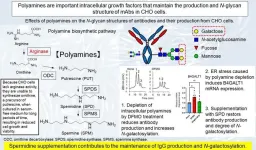(Press-News.org) CHAMPAIGN, Ill. — A new study links increased use of acetaminophen during pregnancy – particularly in the second trimester – to modest but noticeable increases in problems with attention and behavior in 2-, 3- and 4-year-olds. The study adds to a growing body of evidence linking the frequent use of acetaminophen in pregnancy to developmental problems in offspring.
The findings are detailed in the journal Neurotoxicology and Teratology.
The research is part of the Illinois Kids Development Study at the University of Illinois Urbana-Champaign, which explores how environmental exposures influence child development. The study tracked hundreds of children, collecting data on their prenatal chemical exposures and asking caregivers to assess their behaviors and traits at ages 2, 3 and 4.
While acetaminophen is considered the safest painkiller and fever reducer available during pregnancy, previous studies have found evidence of a range of possible negative outcomes for children exposed to the drug in gestation, said Megan Woodbury, who led the research as a graduate student at the U. of I. with comparative biosciences professor emerita Susan Schantz, the principal investigator of the IKIDS program at Illinois. Woodbury is now a postdoctoral researcher at Northeastern University in Boston. Schantz is a faculty member of the Beckman Institute for Advanced Science and Technology at the U. of I.
A recent study led by Woodbury and Schantz linked higher acetaminophen exposure in pregnancy to language delays in children.
Some previous studies have found no relationship between acetaminophen use in pregnancy and attention and behavior in childhood, while other, usually larger studies found relationships between more frequent use of the medication during pregnancy and attention-related and behavioral problems in offspring. Most of the latter studies were conducted in older children and questioned pregnant participants about their use of acetaminophen at most once per trimester. The new study asked pregnant parents about their acetaminophen use six times over the course of the pregnancy – roughly once every four-to-six weeks – offering a more precise picture of the magnitude and timing of the drug exposures.
The researchers also asked caregivers to answer dozens of standardized questions about their child’s behavior and ability to pay attention at ages 2, 3 and 4. More than 300 children were assessed at age 2, with 262 assessed again at 3, and 196 at age 4.
“Our most important finding was that with increasing acetaminophen use by pregnant participants, especially during the second trimester, their children showed more attention-related problems and ADHD-type behaviors, which we call ‘externalizing behaviors,’ at every age we measured,” Woodbury said.
“The kinds of behaviors the caregivers reported included things like the child talking out of turn, not paying attention, not being quiet when they were supposed to be quiet, not sitting down when they were supposed to be sitting down, and being a little aggressive with other children,” Schantz said.
The findings are not an indication that the children have attention-deficit/hyperactivity disorder or that they will be diagnosed with ADHD at a later date, Schantz said. But the children seem to be having more trouble with attention than peers of the same age who were less exposed or not exposed to acetaminophen in the womb.
Woodbury, who herself is pregnant, says she does not want to scare others away from using acetaminophen in pregnancy when needed. Extreme headaches or other painful episodes and fevers can be debilitating and even dangerous, calling for use of the drug. She said she has turned to acetaminophen once per trimester so far. But she also chooses not to use it for minor aches, pains or slight fevers.
More research is needed to test whether more frequent use of acetaminophen during the second trimester of pregnancy may be particularly problematic for the developing brain, the researchers said. The study also is limited as participants were mostly white, non-Hispanic and of higher economic status. Schantz and her team are working to broaden the cohort of participants in IKIDS to include pregnant people from a greater diversity of social, economic and racial backgrounds.
This research was supported by the Children’s Environmental Health and Disease Prevention Research Center funded by the National Institute of Environmental Health Sciences and the U.S. Environmental Protection Agency and the National Institutes of Health Environmental Influences on Child Health Outcomes program.
Editor’s notes:
To reach Susan Schantz, email schantz@illinois.edu.
To reach Megan Woodbury, email m.woodbury@northeastern.edu.
The paper “The relationship of prenatal acetaminophen exposure and attention-related behavior in early childhood” is available online.
END
Higher acetaminophen intake in pregnancy linked to attention deficits in young children
2024-01-16
ELSE PRESS RELEASES FROM THIS DATE:
Manipulating polyamines to enhance antibody efficacy: A novel approach in biotechnology
2024-01-16
Monoclonal antibodies (mAbs) are laboratory-designed proteins that mimic the immune system's antibodies. To date, many therapeutic mAbs belonging to the immunoglobulin G (IgG) class of antibodies, have been approved for the treatment of cancer and autoimmune diseases. Cell lines such as the Chinese hamster ovary (CHO) cells are generally used to produce mAbs. Notably, the production and manufacture of mAbs are regulated by critical quality attributes (CQAs) to ensure their safety and efficacy in treatment.
An important CQA for mAbs is the N-linked glycosylation present at a specific position (Asn297). N-linked glycans consist of N-acetylglucosamine (GlcNAc), mannose (Man), fucose ...
New initiative focuses on oral health clinicians in prevention and early detection of heart disease
2024-01-16
DALLAS, JANUARY 16, 2024 — A patient’s oral health can be an indicator of overall health and well-being. Research shows that chronic gum inflammation may be associated with other chronic diseases including coronary artery disease and diabetes.[1] In addition, certain bacteria that live in the mouth can travel through the bloodstream to other parts of the body, including the heart and lungs. Oral bacteria, including viridans group streptococcal (VGS), can cause infective endocarditis, an infection of the inner ...
Cannabis activates specific hunger neurons in brain
2024-01-16
PULLMAN, Wash. – While it is well known that cannabis can cause the munchies, researchers have now revealed a mechanism in the brain that promotes appetite in a set of animal studies at Washington State University.
The discovery, detailed in the journal Scientific Reports, could pave the way for refined therapeutics to treat appetite disorders faced by cancer patients as well as anorexia and potentially obesity.
After exposing mice to vaporized cannabis sativa, researchers used calcium imaging technology, which is similar to a brain MRI, to determine how their brain cells responded. They observed that cannabis activated a set of cells in the hypothalamus when the rodents anticipated ...
Advancement in thermoelectricity could light up the Internet of Things
2024-01-16
Osaka, Japan – Imagine stoplights and cars communicating with each other to optimize the flow of traffic. This isn’t science fiction – it’s the Internet of Things (IoT), i.e., objects that sense their surroundings and respond via the internet. As the global population rises and such technologies continue to develop, you might wonder – what will power this digital world of tomorrow?
Wind, solar, yes. Something all around us might not immediately come to mind though – heat. Now, in a study recently published in Nature Communications, a multi-institutional research team including Osaka University has unveiled a ...
Largest-ever study of ocean DNA has created essential catalog of marine life
2024-01-16
The ocean is the world’s largest habitat, yet much of its biodiversity is still unknown. A study published in Frontiers in Science marks a significant breakthrough, reporting the largest and most comprehensive database of marine microbes to date – matched with biological function, location, and habitat type.
“The KMAP Global Ocean Gene Catalog 1.0 is a leap toward understanding the ocean’s full diversity, containing more than 317 million gene groups from marine organisms around ...
Research aims to harness technology for improved heart and brain health
2024-01-16
Highlights:
Research teams share findings and progress on projects aimed at harnessing digital solutions — including text messaging, smartphone apps, wearable devices and artificial intelligence — to improve health, reduce health care disparities, empower people to better manage their health and wellness and enhance patient/clinician connectivity in a special issue of the Journal of the American Heart Association.
Topics in this issue include:
the effectiveness of an “EyePhone” smartphone application to diagnose ...
Living in poverty with chronic inflammation significantly increases heart disease and cancer mortality risk, study finds
2024-01-16
In the US, approximately 37.9 million people, or 11.4% of the population, lived below the poverty line in 2022. It has been well demonstrated that poverty negatively affects physical and mental health. For example, people living in poverty run a greater risk of mental illness, heart disease, hypertension, and stroke, and have a higher mortality and lower life expectancy. The mechanisms by which poverty impacts on health outcomes are manifold: for example, people experiencing poverty have reduced access to healthy food, clean water, safe housing, education, and healthcare.
Now, researchers have shown for the first time that the effects of poverty may combine in ...
Chronic inflammation and poverty are a ‘double whammy’ for mortality risk
2024-01-16
A new study led by a University of Florida College of Public Health and Health Professions researcher finds that people with chronic inflammation living in poverty have more than double the risk of dying from heart disease and nearly triple the risk of dying from cancer within the next 15 years. The findings are based on data representing 95 million Americans ages 40 and over.
While chronic inflammation and poverty are each known to increase mortality risk, when combined, the two factors appear ...
No increase in preventable illnesses, deaths in kids during pandemic, but delays in some diagnoses
2024-01-16
Despite major disruptions to health care systems during the COVID-19 pandemic, there was no significant increase in preventable conditions or deaths in children according to a large study published in CMAJ (Canadian Medical Association Journal) https://www.cmaj.ca/lookup/doi/10.1503/cmaj.221726.
To understand the effect of the pandemic on pediatric health care use and children's health, researchers looked at data on emergency visits, hospital admissions and deaths for children aged 0–17 years ...
Cannabis has no clear effect on treatment of opioid addiction, US study finds
2024-01-16
Cannabis is not an effective treatment for opioid addiction, a new peer-reviewed study of thousands of people being treated for opioid use disorder suggests.
Experts, publishing their results today in The American Journal of Drug and Alcohol Abuse, have found that cannabis is having no significant effect on peoples’ use of opioids, taken outside of medical guidance.
The findings have substantial implications for U.S treatment programmes, some of which still require patients to abstain from cannabis before they qualify for potentially life-saving treatment. This is based on ...




